Note: The winning intersection has been announced.
The nominations are in. In no particular order, here are this year’s nominees for Worst Intersection in Seattle (click on images for map):
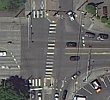 7th Ave NE and NE 45th – “The bizarre center-of-the-intersection crosswalk, the fact you have to wait three whole signal changes to cross catty-corner (which nobody does), the fact that it’s the only “safe” crossing of 45th for several blocks headed east (so you end up with mass jaywalking). Just awful.” (nominated by Tom F)
7th Ave NE and NE 45th – “The bizarre center-of-the-intersection crosswalk, the fact you have to wait three whole signal changes to cross catty-corner (which nobody does), the fact that it’s the only “safe” crossing of 45th for several blocks headed east (so you end up with mass jaywalking). Just awful.” (nominated by Tom F) Aurora and cross streets Republican, Harrison, Thomas, and John – “These intersections all suck for not existing, pedestrian-speaking. We have enough geographic barriers to movement in this town, we don’t need to create our own with concrete.” (nominated by Hans)
Aurora and cross streets Republican, Harrison, Thomas, and John – “These intersections all suck for not existing, pedestrian-speaking. We have enough geographic barriers to movement in this town, we don’t need to create our own with concrete.” (nominated by Hans) Eastlake NE and Fuhrman E – “ear-crushing noise off I5, car drivers rushing to turn off or onto the University Bridge, which often means navigating around a ‘oh hey a pedestrian’ car stopped across the pedestrian walkway, which pushes you out into the Bicycle Lane, who in turn have their own troubles with cars failing to yield.” (nominated by Jeremy Mates)
Eastlake NE and Fuhrman E – “ear-crushing noise off I5, car drivers rushing to turn off or onto the University Bridge, which often means navigating around a ‘oh hey a pedestrian’ car stopped across the pedestrian walkway, which pushes you out into the Bicycle Lane, who in turn have their own troubles with cars failing to yield.” (nominated by Jeremy Mates)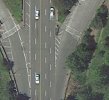 Bridge Way exit off of Aurora – “Has the most dangerous sidewalk in the city. I believe many people would get hit there were people actually using it. It is a soft turn off of Aurora, so drivers come flying around at 50+ mph. Drivers can’t see if anyone is on the crosswalk and pedestrians can’t see if anyone’s coming toward it. To make matters worse, there’s a two foot drop from the sidewalk to the street, so if you saw a car was coming at the last minute, it wouldn’t be easy to get back to safety. When I’ve walked up Aurora this way, I’ve gone way out of my way to 38th to get back onto Aurora, rather than put my life on the line trying the direct path.” (nominated by NJL)
Bridge Way exit off of Aurora – “Has the most dangerous sidewalk in the city. I believe many people would get hit there were people actually using it. It is a soft turn off of Aurora, so drivers come flying around at 50+ mph. Drivers can’t see if anyone is on the crosswalk and pedestrians can’t see if anyone’s coming toward it. To make matters worse, there’s a two foot drop from the sidewalk to the street, so if you saw a car was coming at the last minute, it wouldn’t be easy to get back to safety. When I’ve walked up Aurora this way, I’ve gone way out of my way to 38th to get back onto Aurora, rather than put my life on the line trying the direct path.” (nominated by NJL)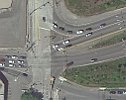 Mercer / I-5 ramps and Fairview – “Basically a 8-lanes of freeway onramp / offramp. Not only can’t you cross Mercer at all on the east side of Fairview, but if you’re on the north side of Mercer, there are no pedestrian signals to cross any street – you’ll have to walk a block back north to cross Fairview at Valley.” (nominated by Troy)
Mercer / I-5 ramps and Fairview – “Basically a 8-lanes of freeway onramp / offramp. Not only can’t you cross Mercer at all on the east side of Fairview, but if you’re on the north side of Mercer, there are no pedestrian signals to cross any street – you’ll have to walk a block back north to cross Fairview at Valley.” (nominated by Troy)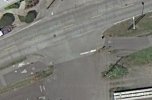 Latona Ave NE and NE Pacific St – Pedestrians have to “dodge cars, large trucks AND bikes at this intersection. The Burke Gilman trail merges with the sidewalk at this intersection so you have large numbers of bikes, many moving fast, that must be avoided by pedestrians. The noise from the I-5 bridge makes any attempt to warn “on your left” impossible to hear. Large trucks entering and leaving Dunn Lumber have a steep hill that they must stop on before pulling across the Burke Gilman trail/sidewalk and turning onto Pacific. Vehicles on Pacific turning south on Latona must not only do the usual checks but also look over their shoulder for fast moving bikes on the Burke Gilman. A mess for all!” (nominated by pat)
Latona Ave NE and NE Pacific St – Pedestrians have to “dodge cars, large trucks AND bikes at this intersection. The Burke Gilman trail merges with the sidewalk at this intersection so you have large numbers of bikes, many moving fast, that must be avoided by pedestrians. The noise from the I-5 bridge makes any attempt to warn “on your left” impossible to hear. Large trucks entering and leaving Dunn Lumber have a steep hill that they must stop on before pulling across the Burke Gilman trail/sidewalk and turning onto Pacific. Vehicles on Pacific turning south on Latona must not only do the usual checks but also look over their shoulder for fast moving bikes on the Burke Gilman. A mess for all!” (nominated by pat) Westlake and Valley/Broad – “It is particularly dangerous if you are trying to cross Westlake on the north side of the intersection. It is a soft right turn for people traveling east on Valley and turning onto Westlake, so most don’t slow down at all or bother to consider there might be pedestrians who have the right of way. Also, the cross walk a block up Westlake is mostly useless, as no one ever stops for it.” (nominated by NJL)
Westlake and Valley/Broad – “It is particularly dangerous if you are trying to cross Westlake on the north side of the intersection. It is a soft right turn for people traveling east on Valley and turning onto Westlake, so most don’t slow down at all or bother to consider there might be pedestrians who have the right of way. Also, the cross walk a block up Westlake is mostly useless, as no one ever stops for it.” (nominated by NJL) Pine and Boren – A very busy pedestrian intersection, with pedestrians exposed to the noise from the freeway below and surrounded on all sides with cars and concrete. “I keep hoping those overpasses are near their end-of-life so they can be replaced with something that buffers the noise, ideally with some vegetation.” (nominated by Tom F)
Pine and Boren – A very busy pedestrian intersection, with pedestrians exposed to the noise from the freeway below and surrounded on all sides with cars and concrete. “I keep hoping those overpasses are near their end-of-life so they can be replaced with something that buffers the noise, ideally with some vegetation.” (nominated by Tom F)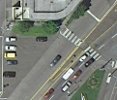 Fairview and Eastlake – “The sidewalk vanishes into a parking lot. The parking lot itself is barely distinguishable from the road when it isn’t filled with cars.” (nominated by NJL)
Fairview and Eastlake – “The sidewalk vanishes into a parking lot. The parking lot itself is barely distinguishable from the road when it isn’t filled with cars.” (nominated by NJL)
[poll id=”6″]
Update: The winning intersection has been announced.



